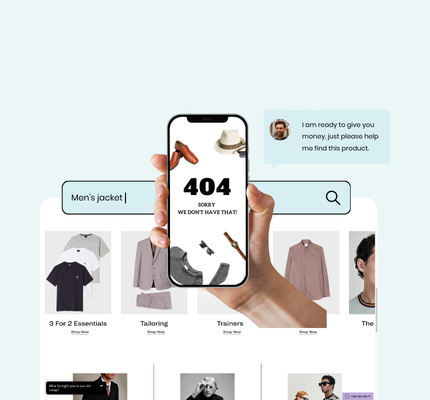Blog
The Evolution of Retail: How E-Commerce Can Learn from the Past
E-commerce is a rapidly changing industry and many brands admit they struggle to keep pace with technological advancements. But what lessons can you learn from the evolution of retail, to help you stay ahead of the curve?
For as long as mankind has existed, we’ve exchanged goods and services. As civilization evolved, trade was a huge governing factor in how and where humanity spread. Resources were precious not only for their inherent use, but for their power to unlock access to items that were scarce locally. Trade routes opened up whole new worlds and brought different cultures together.
Archaeological evidence confirms the importance of retail to humanity. Settlements typically grew up around a road (providing passing trade and access to more goods) or a marketplace. These hubs of commerce were a focal point for communities, forming the basis of daily life, routine and traditional customs. And of course retail continues to play a huge part in modern-day town planning.
In its earliest form, retail was based around barter systems, but as early as the Bronze Age, token commodities such as cowrie shells were exchanged in lieu of actual goods. As standardized coinage started to emerge around 700 BC, traders were freed from the restrictions of a “coincidence of wants”. Retail, as we recognize it today, could really begin to expand.
Commerce is such a core part of humanity’s evolution and history — so what can today’s cutting-edge e-commerce businesses learn from the way that retail evolved?
Marketplaces: Then and Now
It’s impossible to dig into the evolution of retail without paying serious attention to the marketplace. This form of commerce has dominated the retail landscape for centuries — and continues to do so in many ways.
One of the reasons we love markets in their original form is they don’t have a solely commercial purpose. They’re a social space, and as conscious consumerism continues to rise, the appeal of shopping in a local and independent capacity is growing.
Although wildly successful, online marketplaces fail to provide some of the key benefits offered by their real-life counterparts. They’re typically considered the goliaths of online retail, and distance the buyer from the original seller. Similarly, economies of scale ensure that elaborate fulfillment networks can ship goods from sellers all around the world — a departure from the ‘buy local’ mentality of the classic model.
But arguably the core appeal of the marketplace comes from our love of choice and convenience — a ‘one-stop shop’ that promises to meet all of our needs in a single shopping expedition. This simple trait is perhaps the most significant contributing factor in the success of marketplaces of all kinds.
The online marketplace — unfettered by physical restrictions, the need for traders in close proximity, and with a hypothetically unlimited audience — has traded on this to epic effect. According to data from Juniper Research, revenues for marketplace platform providers across the globe are predicted to more than double from $18.7 billion in 2017 to $40.1 billion in 2022.
Lesson learned: The choice and convenience offered by the marketplace model have made it a firm favorite throughout history. But modern online versions often lack the original social, community aspect — something that D2C retailers are starting to work to their advantage.
On / Off Relationship: Retail and the Internet
It may feel as though retail made the jump from the offline to virtual space in relatively recent history, but we’ve been doing business online for decades. Things really took off in the mid-1990s when domestic internet connections became affordable and reliable. This is when large marketplaces such as eBay, Amazon and Alibaba all launched.
At the same time we saw the rapid and forceful evolution of established highstreet brands. But those who failed to heed the seismic shift in consumer behavior, or undervalued the potential of a strong online presence, fell by the wayside. A mass extinction of well-known retailers characterized the 2000s. Toys R Us struggled to maintain a huge physical footprint, Blockbusters’ business model felt prehistoric during the dawn of streaming services, and no amount of restructuring could save once-loved British department store, BHS.
It’s interesting that while most offline retailers now have some kind of online presence, some exclusively online stores have also ventured out into the real world. These pop-ups and pilot schemes are more than just a PR play. They recognize the shift we’re beginning to see around nostalgia and fondness for IRL shopping.
There’s growing recognition that if we want to see busy, thriving city centers, shoppers must ‘use it or lose it’. Expectations for brick and mortar shopping experiences are still high, but this is just one more reason why an omni-channel approach is so vital in today’s market.
Kiehl’s is one retailer that’s constantly responded to new opportunities, while continuing to trade on its past. As one of the oldest retailers in the US (close to 170 years old) they remain relevant to a modern, multi-generational customer base. This kind of loyalty supports successful expansion in all directions — offline, online and throughout international standalone stores as well as stockists. Kiehl’s have shown fluidity in their adoption of an omni-channel approach, with innovative ways to bring offline experiences online.
Klevu client Richer Sounds has also adapted flexibly to the ever-shifting commerce market. As well as running a highly successful e-commerce operation, it commands an exceptionally strong brick and mortar presence and has even been recognized by Guinness World Records as having the highest sales per sq ft of any retailer in the world over the past 25 years.
Lesson learned: Retailers must pay close attention to shifting public sentiment. The convenience of e-commerce has reigned supreme for the past decade — but tangible, carefully curated shopping experiences are back in vogue and starting to gain traction.
What Goes Around: Retail Trends Coming Full Circle
The retail tactics that prove timeless are the ones that tap into deeply ingrained and universal behaviors, wishes, fears and desires. We jokingly refer to ‘retail therapy’, but the truth is that shopping does have a distinct and powerful impact on our brain chemistry. The neurotransmitter dopamine skyrockets in anticipation of a purchase, signaling the expectation of a reward. The effect on the hunter gatherer element of our psyche is even greater when sale pricing or special offers enter the equation, heightening our emotional response and subsequent ‘shopper’s high’.
For thousands of years, retail tactics have evolved in harmony with these psychological responses. They’ll continue to adapt to meet the expectations of a modern audience. A great example of this is store assistants, used for decades to help bump up the AOV of shoppers in store. While they used to take the form of employees with a ‘Here to help’ badge, today they’re armed with iPads to take payments and check stock. Online, they’ve morphed into sophisticated chatbots and the kind of high accurate recommendations served up by on-site search fueled by machine learning.
Conversational commerce is another modern interpretation of a very basic human need for connection and collaboration. With the increasing capacity of modern NLP such as that leveraged by Klevu, this is predicted to become a mainstay for the future of e-commerce. 50% of all searches are predicted to be voice searches by 2020, according to comScore.
Lesson learned: The smartest retailers take the ‘oldest tricks in the book’ and apply a modern lens, coupling the wisdom of the past with today’s latest technical capabilities.
Back to the Future
From the medieval marketplace and village general store, right through to the infancy of augmented reality commerce, retail has been around for millennia. It will always be a core element of our daily lives. And while our expectations and experiences may change, the foundations remain the same — convenience, value, choice, availability.
The retailers that remain future-proof will remember this. They will move with the times without letting fads or gimmicks obscure these fundamental principles.
Ultimately, retail is detail, whether online, offline, physical or virtual. The winners within our industry are those who pay attention to the little touches that bring the common human element of commerce to the forefront of our shopping experiences.
To learn more about how Klevu can help finetune a truly user-led shopping experience, schedule a demo today.


